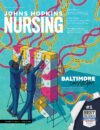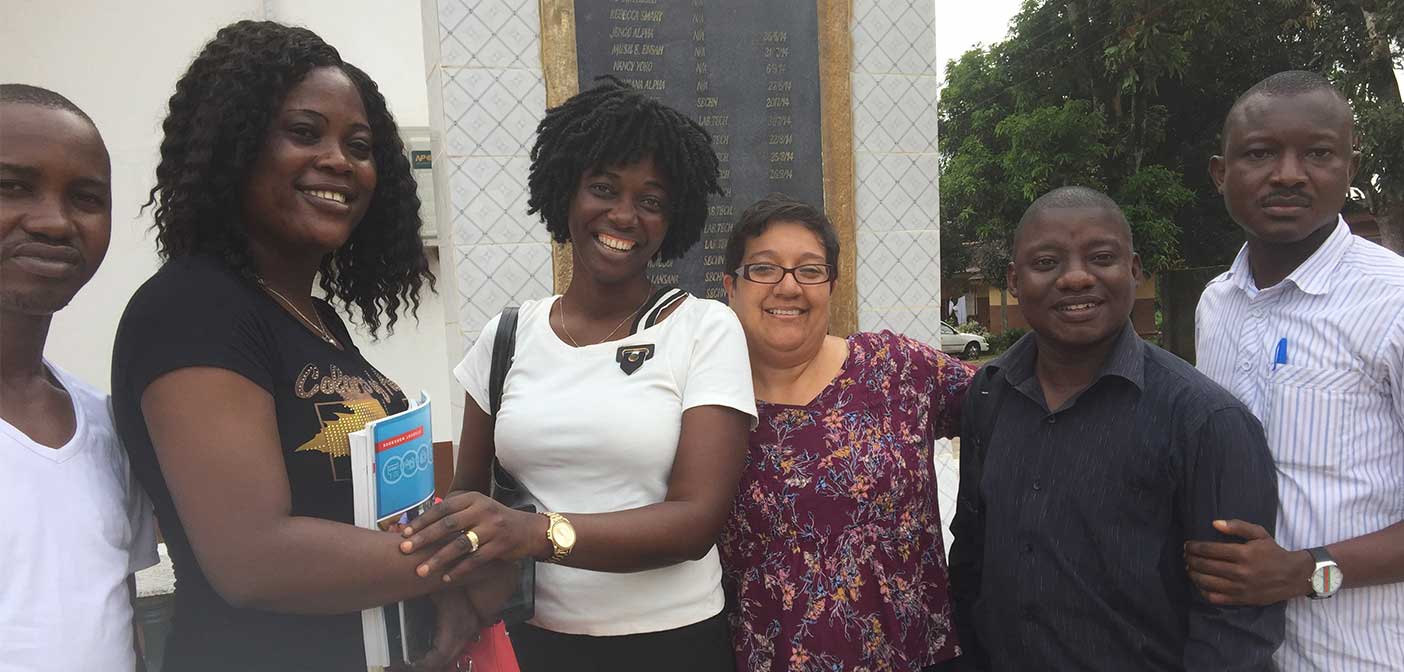By Brennen Jensen
Trip to Sierra Leone recharges Weinberg SICU nurse’s batteries as it builds teams of local life savers
In October, Samantha Young, MS, RN, took a 12-day vacation from her duties as a Clinical Nurse Specialist at the Weinberg Surgical Intensive Care Unit. While she might have used her vacation days, this was no carefree lounging beneath a beach umbrella.
She was part of a visiting medical team performing operations and training in Sierra Leone, which the United Nations ranks among the world’s poorest countries. Life expectancy is less than 52 years in this West African nation still scarred by a brutal civil war that ended in 2002 and an outbreak of Ebola that killed over 4,000 just three years ago. The hospital staff she worked with in the city of Kenema were earnest and dedicated, but beds often lacked linens, pharmacy shelves were mostly bare, and caregivers sometimes had to negotiate lightless hospital corridors by the meek glow of a cellphone. Meanwhile, her hotel was surrounded by razor wire and her bathroom might have a foot of water on the floor. (Then again, on some excursions there were no bathrooms at all.)
And back in Baltimore, Young ended up in the hospital herself—four days of acute gastrointestinal distress and dehydration she figures were brought on by something she ate her last day in Africa. And she can’t wait to do it all again. (Young’s headed back to Sierra Leone in May.)
“The trip was life-changing,” Young says. “I learned that we are so lucky and blessed with everything that we have here. With these continued trips we want to see if we can improve their health systems. I really like being able to make a difference.”
The trips are organized by the Saving Lives Initiative, a nonprofit group founded by Sierra Leone native Abdul-Malik Jalloh-Jamboria, CRNA, a 2010 graduate of the Johns Hopkins School of Nursing. (Young was Jalloh-Jamboria’s preceptor and colleague for a time in Weinberg.) While the group performs medical procedures on biannual treks to Sierra Leone, it is also focused on teaching medical staff on the ground how to teach others to save lives—to help them to help themselves.
Young’s mission was to run classes in Basic Life Support (BLS) and Advanced Cardiac Life Support (ACLS). You could say that on her trip, four members of the team flew in the plane’s baggage hold: the rubberized manikins students use for practice. “We were only allowed carry-on luggage because we had to donate our two checked bags for the manikins and other supplies we brought over,” Young explains.
She ended up teaching BLS and/or ACLS to more than 45 people, including two nurses, two doctors, and the local equivalent of a physician’s assistant who also learned how to be instructors of the techniques. (Even before Young had left Africa, the newly educated life savers had already turned around and trained a number of lay people, including the team bus driver and some security personnel.)
Yes, there were sterilization challenges, language barriers, and periodic blackouts to contend with, but also moments of levity and spur-of-the-moment adaptation. For instance, Young says it’s common in the United States to teach CPR to the bouncy sounds of the ’70s mega-hit “Stayin’ Alive” by the Bee Gees, as the beat conveys the perfect rhythm for pressing on the chest (and, of course, well, the name). But the disco ditty drew blank stares in Sierra Leone.
“They were like, what is ‘Staying Alive’ and who are the Bee Gees?” Young says with a grin. “In the end, they understood the point of the music and we were able to change it to a song that they all knew.”
At Top: Samantha Young, second from right, says she can’t wait to get back to the mission in Sierra Leone.

